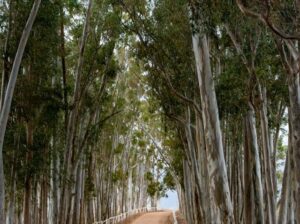Physical Address
23,24,25 & 26, 2nd Floor, Software Technology Park India, Opp: Garware Stadium,MIDC, Chikalthana, Aurangabad, Maharashtra – 431001 India
Physical Address
23,24,25 & 26, 2nd Floor, Software Technology Park India, Opp: Garware Stadium,MIDC, Chikalthana, Aurangabad, Maharashtra – 431001 India

By Aayushi Sharma
Recently, the Kerala government issued an order allowing the Kerala Forest Development Corporation (KFDC) to plant eucalyptus trees for its financial sustenance in 2024-2025. This raised questions because the state government had decided to stop growing eucalyptus as part of its eco-restoration policy. Environmentalists soon protested the decision, arguing that it would adversely affect forests and increase human-animal conflicts in the future. Several political parties and various churches had also strongly opposed the move.
On May 20, the government amended its order to limit the permission to only the cutting of exotic tree species from lands under KFDC’s control. This raises a question, why are these plantations an issue?
What is the role of KFDC in Eucalyptus plantations?
The Kerala Forest Development Corporation (KFDC) was established on January 24, 1975, as part of an initiative to enhance production forestry. According to the KFDC website, the corporation manages approximately 7,000 hectares of plantations. The plantation working circle includes species such as Eucalyptus grandis, Acacia auriculiformis, Acacia mangium, Acacia crassicarpa, Acacia pycnantha (wattle), Alnus nepalensis, Casuarina equisetifolia, and Pinus patula.
Eucalyptus plantations have a rotation age of nine years, Acacia auriculiformis trees eighteen years, and Acacia mangium seven years. At the end of each cycle, plantations approved by the Union Ministry of Environment, Forests and Climate Change are felled.
After clear-felling, the areas are replanted with species listed in a management plan. Experts check soil quality and consult with the Kerala Forest Research Institute before replanting. As of this month, the KFDC website also stated that plantations of exotic species, including eucalyptus, will be converted to indigenous species once the exotic flora has been felled, making the process more ecologically and environmentally friendly.
In what ways does eucalyptus plantation harm the environment?
The impact of Eucalyptus on soil has been recognized, particularly its high nutrient consumption, leading to soil exhaustion and decreased crop yields. Actuall, poor forestry practices, such as high planting densities and short crop rotations, are blamed for soil nutrient depletion, increased erosion, and suppression of undergrowth.
Eucalyptus trees do not support local wildlife
A recent study by the Kerala State Forest Protective Staff Organisation, an association of frontline forest officers, found that replacing exotic plants in forested areas with native species could help provide food for wild elephants at Chinnakanal in Munnar. The policy also highlighted the serious damage invasive species cause to natural habitats and ecosystems, emphasising the urgency of eradicating these species.
In 2021, the Kerala State Government published an eco-restoration policy aimed at addressing the “proliferation of invasive species that are not suitable for our environment” and the resulting “depletion of natural forests.” According to the policy, this depletion forced wild animals to move into human-occupied land in search of food, thereby increasing the prevalence of human-wildlife conflict.
Contradiction with Kerala’s eco-restoration policy
Environmental activists argued that the State’s order permitting KFDC to plant eucalyptus trees contradicted the eco-restoration policy. They claimed it undermined efforts to eliminate invasive species and mitigate human-animal conflicts, thereby threatening both the environment and the well-being of local wildlife (KFDC) (CDIT). Kerala government had introduced the policy to phase out industrial plantations of eucalyptus, acacia, wattle, and pine by 2024 and replace them with natural forests. A senior Taxonomist and Ecologist Dr. Priyadarsanan Dharma Rajan told CFC India, “To save the natural ecosystem, the focus should be on maintaining heterogeneity of the ecosystem. Thus, there should be a diverse range of species for better functioning of the ecosystem.”
References:
Photo by Pat Whelen
https://www.pexels.com/photo/gray-concrete-road-between-green-trees-10052860
Photo by Magda Ehlers https://www.pexels.com/photo/a-dirt-road-surrounded-by-tall-trees-5283414/
Photo by Diego F. Parra https://www.pexels.com/photo/great-blue-heron-sitting-on-mangrove-18426922/
Comments are closed.
svc1kv